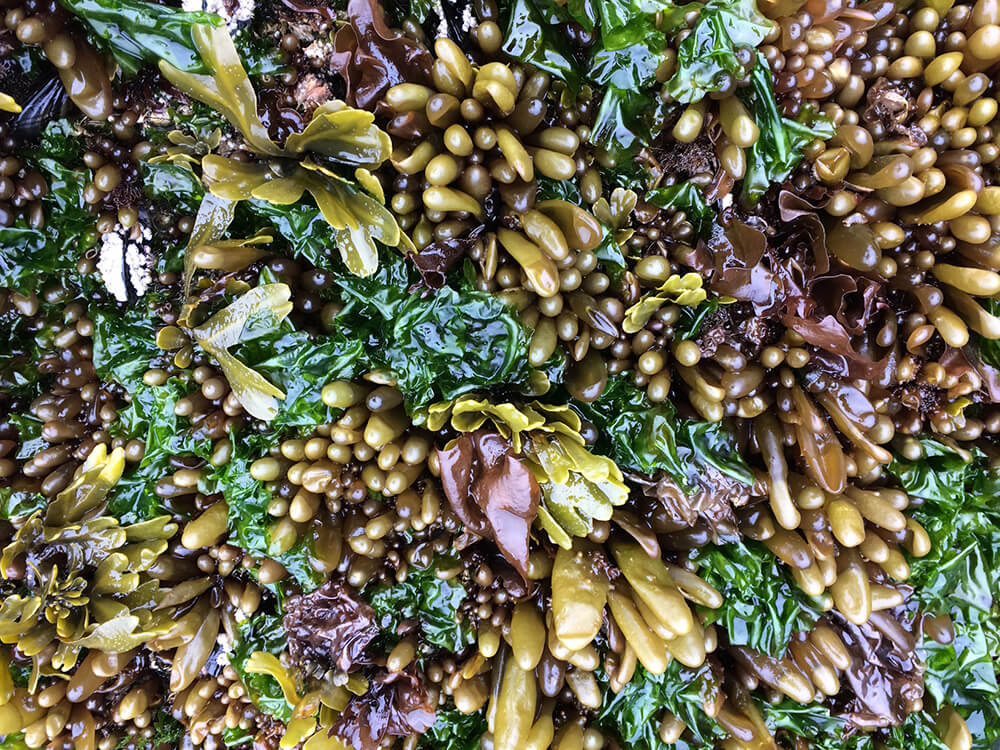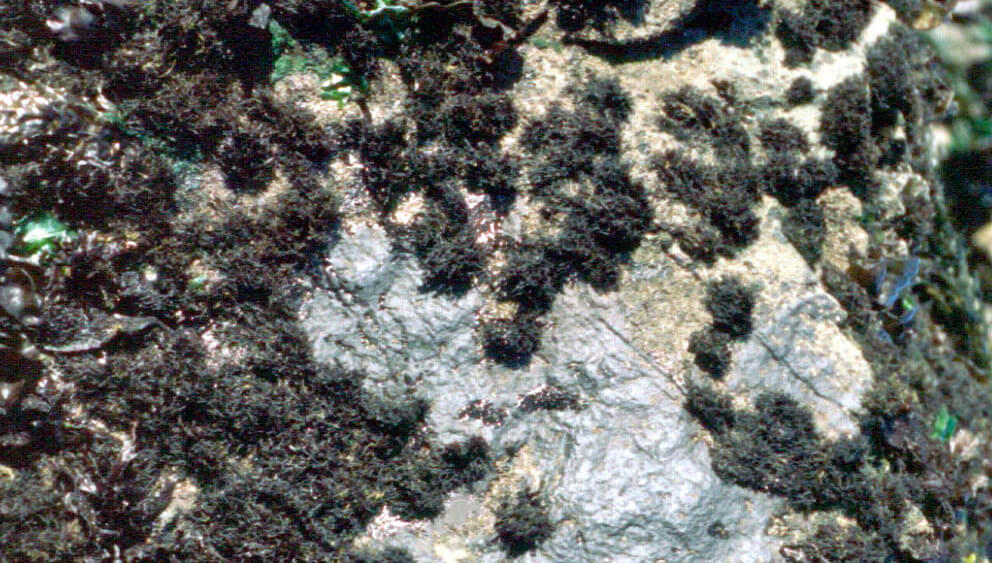Seaweeds

Seaweeds include numerous species of marine plants and algae, from the microscopic phytoplankton to the enormous giant kelp that form forests beneath the sea. Seaweeds are fundamental to marine ecosystems as they can provide food, shelter, breeding grounds, and habitat for countless organisms.
Our seaweed flora includes green, red, and brown algae along with surfgrass, a true flowering plant.
Common seaweeds in Olympic Coast National Marine Sanctuary
Black Pine
Neorhodomela larix

Size: up to 12 in (30 cm) tall
Habitat: low intertidal
Phylum: Rhodophyta (red algae)
Caloric Value: moderate, though it contains bromophenols that prevent some grazing.
Vegetation present year-round?: yes
Reproduction: Separate male and female plants. Black pine has two life cycles (one reproductive and one not) that are indistinguishable.
Notes: This species is more tolerant of sand than many other rocky intertidal algae. It grows in mats and can out-compete other algae with its quick growth.
Bottlebrush Algae
Endocladia muricata

Size: 1.5-3 in (4-8 cm)tall
Habitat: high tide zone; on rocks
Phylum: Rhodophyta (red algae)
Caloric Value: high
Eaten by: sometimes limpets
Vegetation present year-round?: yes
Reproduction: Bottlebrush algae has two life cycles (one reproductive and one not) that are indistinguishable.
Notes: Bottlebrush algae is well adapted to the high intertidal zone with a resistance to drying and the ability to withstand relatively high temperatures.
Bull Kelp
Nereocystis luetkeana

Size: 33 ft (10-36 meters) to a record 118 feet.
Habitat: low tide zone
Phylum: Ochrophyta (brown algae)
Caloric Value: high, especially in protein, calcium, and iron.
Eaten by: limpets, chitons, and urchins
Vegetation present year-round?: Bull kelp is usually ripped up by winter storms only to regrow in the spring.
Notes:
- The hollow bulb was used by coastal Native Americans to carry water; stems called stipes were dried and used for fishing line. It was also pickled and eaten by early pioneers.
- Kelp forests provide shelter for fishes. Seabirds rest in calmed sea around the fronds. Sea otters wrap in the blades to "anchor" themselves. The blades also provide a hard surface for mussels and bryozoans to attach.
- One of the fastest growing plants—can grow up to half a foot a day, to a height of almost 100 feet!
Coralline Algae
Order: Corallinales

Size: 1-2 mm, a thin coating
Habitat: low to mid tide zone
Phylum: Rhodophyta (red algae)
Eaten by: Northern abalone, some limpets, and lined chitons
Vegetation present year-round?: yes
Reproductions: Reproduction occurs within the algae. Sometimes, you can find small bumps on the surface of the algae where reproduction takes place. Separate male and female plants.
Notes: Coralline takes calcium out of the water. This calcium carbonate gives them a coral-like look. As they die, they turn white. There are a number of different species that are difficult to differentiate.
Giant Kelp
Macrocystis pyrifera

Size: 100 ft (30 m) long
Habitat: low tide zone
Phylum: Ochrophyta (brown algae)
Eaten by: red and purple urchins, bat star, kelp crab
Vegetation present year-round?: no. It dies off each winter, but grows back quickly in the early spring. Giant kelp can grow up to 14 inches in one day, putting it in the running for fastest plant growth in the world.
Reproductions: Giant kelp releases spores into the water.
Notes: Giant kelp and bull kelp are the key species in the kelp forests which stretch from Northern California to Alaska. Often plants are destroyed in winter storms and they grow back in the spring. Sanctuary studies show that giant kelp provides important breeding grounds and protection for young rockfish and numerous other species.
Laver or Nori
Porphyra sp.

Size: Mid-size 4-20 in (10-50 cm) long
Habitat: mid tide zone
Phylum: Rhodophyta (red algae)
Caloric value: One of the highest caloric values for marine algae.
Eaten by: limpets and other grazers
Vegetation present year round?: no
Reproduction: Very complex, two life cycles.
Notes: Cultivated worldwide as food. The alternate generation is a microscopic plant which grows inside the shells of marine mollusks like mussels and barnacles.
Rockweed
Fucus sp.

Size: 20 in (50 cm)
Habitat: high to mid tide zone
Phylum: Ochrophyta (brown algae)
Caloric value: moderate
Eaten by:periwinkle snails, some limpets, and the rockweed isopod
Defense: Rockweed secretes polyphenols that inhibit digestion. These are especially active when parts of the seaweed are being grazed.
Present year-round: yes
Reproduction: When eggs are released, a chemical encourages the release of sperm. Fertilized eggs quickly attach to rock.
Notes: Native Americans on the Olympic Peninsula discovered the gel inside the bulbs is useful to treat sunburns and cuts. Rockweed is not usually the first algae to settle in an area after a disturbance leaves rock bare. Grazing animals clear spots in the more aggressive algae, then rockweed finds a place to settle.
Sea Cauliflower
Leathesia difformis

Size: Up to 2 in (5 cm) long, though usually smaller
Habitat: mid to low tide zones
Caloric Value: low
Phylum: Ochrophyta (brown algae)
Vegetation present year-round?: Sea cauliflower is an annual. It dies out in the winter.
Notes: Sea cauliflower often settles on another plant and takes nothing from the host plant. Therefore, it is a true epiphyte. Sea cauliflower does not tolerate high temperatures. It is often said to resemble a miniature brain.
Sea Lettuce
Ulva spp.

Size: 7 in (18 cm)
Habitat: high tide zone; attached or free-floating
Phylum: Chlorophyta (green algae)
Caloric value: high
Eaten by: shore crabs, mollusks
Reproduction: Alternative generations (like ferns) produce one life stage that reproduces sexually and one that reproduces asexually.
Notes: Sea lettuce is one to two cells thick. The Danish species has been shown to absorb glucose and acetate from sea water, stimulating growth.
Sea Palms
Postelsia palmaeformis

Size: Up to 24 in (60 cm)
Habitat: Grows in areas with extreme wave action. The flexible stems called stipes in seaweeds bend to absorb wave energy.
Phylum: Ochrophyta (brown algae)
Caloric value: low
Vegetation present year-round?: no
Reproduction: Spores develop on the back side of the blades. They are released in late spring. Notes: Sea palms can grow on mussels. This makes the mussels more susceptible to being pulled off rocks by wave action. New sea palms will then grow in to replace the missing mussels.
Sea Staghorn or Dead Man's Finger
Codium Fragile

Size: To 12 in (30 cm)
Habitat: low intertidal and subtidal zones.
Caloric value: low
Eaten by: A specialized sea slug
Vegetation present year round?: yes
Reproduction: Some plants are male and some female
Notes: Staghorn is a "siphonous alga" which means that it is composed of filaments that interweave and are in fact only one multinucleated cell. In the northeastern United States, a cyanobacteria has been found to live in staghorn. This bacteria produces nitrogen for the plant. Further studies need to be done in the northwest to see if that is true of the staghorn that live here as well.
Surfgrass
Phyllospadix sp

Size: Up to 3 ft (1 m)
Habitat: rocky areas, low intertidal
Phylum: Tracheophyta (vascular plant)
Caloric value: high
Vegetation present year-round?: yes
Reproduction: Surfgrass is a true plant not an alga. It has roots and flowers.
Notes: While it is a true plant, surfgrass does not have stomata (similar to pores) like terrestrial plants, This helps to prevent water loss in their salty environment. The outer wall of surfgrass is thickened to protect the plant. Surfgrass communities provide an important protected environment for intertidal life. Surfgrass is also high in protein. Because it plays an important biological role and it is sensitive to environmental changes, it is a keynote species.
Winged Kelp
Alaria Marginata

Size: 8-10 ft (2-3 m)
Habitat: rocky intertidal, low tide zone
Phylum: Ochrophyta (brown algae)
Vegetation present year round?: yes
Reproduces: The reproductive sporophytes are low on the blade. They contain a chemical that discourages grazing.
Notes: Alaria tends to out-compete in areas of high-wave action.

